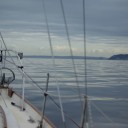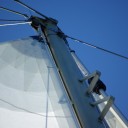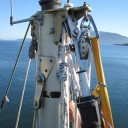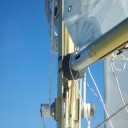Trying out our new North Sails
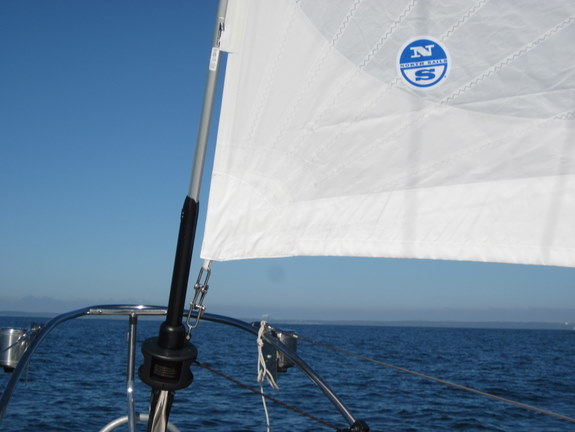
April 20th, 2011 | by Marilyn | Published in Sails, Upgrades
Yes, it’s true – we bought new sails! Though our original plan was to try to make our own sails – we decided to go with the professionals. I’ll give a review of how everything went.
We worked with Angus Brackett of the North Sails Seattle loft. The purchase process went well – Angus was very attentive to our questions, made the 1.5 hour journey out to measure our boat, offered useful advice about changing to a Harken Mark IV Unit 1 roller furler. Angus and North Sails helped us locate the new forestay and Harken parts that we needed at very reasonable prices. So far, so good – we started out very happy with North Sails and Angus Brackett. But of course the proof was in how the new North Sails fit, once they arrived. We eagerly awaited about 6 weeks for delivery.
Angus Brackett delivered the new North Sails on Sept 27, 2010. I sat on the dock as he raised the furling genoa (NorRadian cut) – it seemed a little short from my perspective, but he leaned back and said – “yep, that’s great, couple inches for stretch, that’s just right”. So I said nothing because I trusted his judgment. That’s why we hired professionals, right?
Angus then raised the main. From my perspective on the dock, I could clearly see the top full batten was getting stuck on the backstay. After some useful discussion about whether this was a problem, Van and I agreed to try sailing on our upcoming week long cruise with the boom lowered about 6-8” from its normal spot so a reasonable force from the wind could pop the mainsail past the backstay as we tacked. If Van and I didn’t like having the boom in that position or were worried about chafe, Angus agreed that North Sails would shorten the batten and remove some of the roach.
Angus then raised the mizzen. I’m delighted to say it went up without problem and it’s worked well. But that main and genoa were not looking good.
The next day, we set off for our 4th summer cruise. (I reported on that earlier). The second day, in Rosario strait as the wind was picking up – we had a halyard wrap while trying to unfurl the genoa!!. Fortunately, we could unwrap it without going up the mast. Van then recognized we did not have the mandatory 8-10 degree angle of entry at the halyard to the top swivel because the head of the genoa was way too low. He started adding shackles to the tack so the sail could be hoisted higher. Cutting a long story short, 9” of additional shackles later, the genoa was high enough that the halyard angle was good, so the halyard wrap problem went away. This means the genoa is cut too small.
We also figured out that if we hoist the main as close to the mast sheave as possible, we still need to lower the boom about 6” to get good luff tension. So the main is cut too big.
Next day, we found some bigger winds on a close reach. To my dismay, the helm was almost more than I could handle. No matter how Van adjusted the mizzen to balance the sailing forces, the severe weather helm continued. This was certainly not how she sailed before with her old sails!
In hindsight, this should not be a surprise. The Main and Mizzen now have battens and a roach, and so they are larger sail areas. The genoa is much smaller, because it’s 135% rather than 150% and we lost ~20” because we added the furler with sufficient room for the anchor. To make matters worse, the genoa luff is a further 9” too short, and the main’s luff is about 4” too long. The genoa force in front of the center of lateral resistance is much smaller, the main and mizzen forces behind the center are much larger – the sail plan is no longer balanced. Add some heel to the boat in a stiff breeze, the rudder loses efficiency through the water – and the weather helm very nearly exceeds my strength. This is bad news.
On our return, Van wrote a report-like email to Angus Brackett at the North Sails Seattle loft stating our findings. To our surprise, when Angus Brackett called the next day, he told Van that he found the email “offensive”. Now, I read it – and it was far from offensive. It was a report of our sail experiences. Van explained over the phone that the intent was not to offend but to report, and held his ground as Angus pressured him on who’s fault it was that the genoa is too short. You see, Angus had measured the boat before the new furler was installed. He told us that it would be no problem. He told us to install the halyard restrainer as close to the top of the mast as possible. He told us to make the top of the furling drum 2.1 feet from the stem fitting. Van installed the furler parts exactly as Angus said. Yet the genoa luff is 9” too short. This is not our fault. Angus eventually relented and agreed to talk to his management.
A couple days later, as promised, Angus got back with us via email and said he had a plan to modify the genoa. The idea is to remove the top panels, and replace them with ones that are about 18 cm longer. This should provide the as-designed sail shape until the very top of the sail, and solve the halyard wrap problem. He also agreed to shorten the main roach so it clears the backstay. So we took the sails into his loft at the start of winter and left him to do the work.
When we finally raised the modified genoa, the furled sail no longer wraps nicely at the top. There is a small gap because the sail shape is odd. This will allow rain and sunlight to enter. Not good. The main is of course still too long also – requiring the boom to be ~6” lower than before. When under sail, the aft end of the boom is lifted slightly so it clears the cabin top. But when the mainsail is dropped, if we want to keep the boom level and clear the cabin top, we have to raise the boom gooseneck. The alternative is to leave the gooseneck in position, and use the topping lift to raise the aft end, which means the boom is no longer level. That’s also the end of the idea of putting solar panels on the cockpit hard top because the boom clearance is no longer sufficient.
We finally used the modified sails for a day sail this spring with a nice ~15 knot wind, and without the mizzen – she sailed beautifully. We set a new personal speed record of 7.2 knots. There was still some weather helm, but I could handle it. We didn’t try putting up the mizzen – we had up enough sail for the conditions. The boat was not healed much, and there was insignificant waves in the protected waters. It was a better experience than last fall when we first tried the new sails.
I’m anxious to learn more about handling these new sails in a variety of conditions. The old sails were like bags, so it’s not a surprise the boat handles differently. We have some new tricks to learn about how to manage the new sails. I wish they were made to a more appropriate sail plan. Angus Brackett and North Sails stood by their promise to make them “fit”, but the end result is not the custom fit we expected. And that’s really sad because sails are too expensive to just try again.
- We know have a roller furling headsail, which Van does not like the concept as much as me.
- Notice how far the swivel is from the top, and how the haylard angle is all wrong. THis is why we had a halyard wrap, before we added all the shackles to the bottom to raise the swivel.
- Here is the swivel position once we added all the shackles at the bottom. What we need to do is make a pendant for the top, and put the tack back where it should be.
- Notice how the boom is lower than the black mark on the mast, which indicates where it is supposed to be located.
